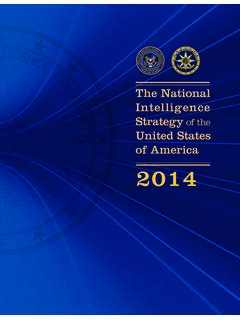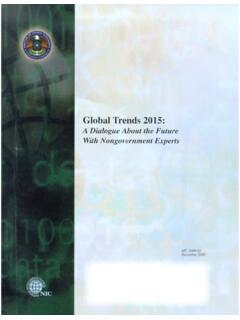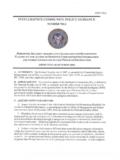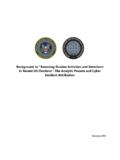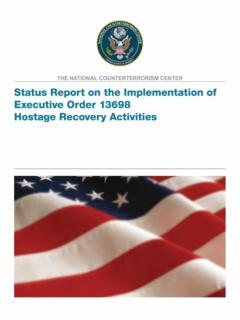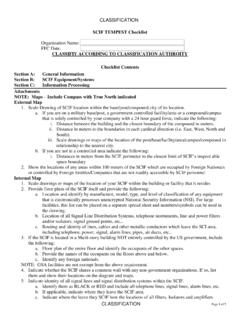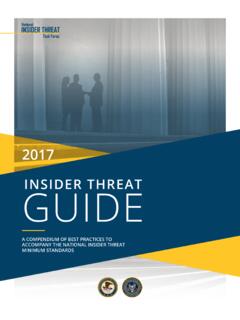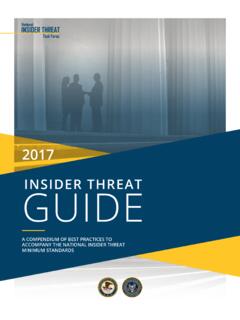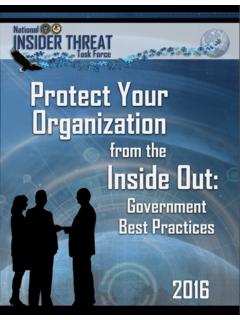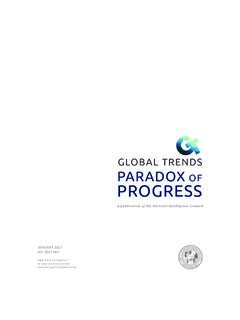Transcription of 13 February 2018 - dni.gov
1 1 13 February 2018 2 STATEMENT FOR THE RECORD WORLDWIDE THREAT ASSESSMENT of the US INTELLIGENCE COMMUNITY February 13, 2018 INTRODUCTION Chairman Burr, Vice Chairman Warner, Members of the Committee, thank you for the invitation to offer the United States Intelligence Community s 2018 assessment of threats to US national security. My statement reflects the collective insights of the Intelligence Community s extraordinary women and men, whom I am privileged and honored to lead. We in the Intelligence Community are committed every day to providing the nuanced, independent, and unvarnished intelligence that policymakers, warfighters, and domestic law enforcement personnel need to protect American lives and America s interests anywhere in the world.
2 The order of the topics presented in this statement does not necessarily indicate the relative importance or magnitude of the threat in the view of the Intelligence Community. Information available as of 8 February 2018 was used in the preparation of this assessment. 3 CONTENTS INTRODUCTION .. 2 CONTENTS .. 3 FOREWORD .. 4 GLOBAL THREATS .. 5 CYBER THREATS .. 5 WEAPONS OF MASS DESTRUCTION AND PROLIFERATION .. 7 TERRORISM .. 9 COUNTERINTELLIGENCE AND FOREIGN DENIAL AND DECEPTION .. 11 EMERGING AND DISRUPTIVE TECHNOLOGY .. 12 TECHNOLOGY ACQUISITIONS AND STRATEGIC ECONOMIC COMPETITION .. 12 SPACE AND COUNTERSPACE.
3 13 TRANSNATIONAL ORGANIZED CRIME .. 13 ECONOMICS AND ENERGY .. 15 HUMAN SECURITY .. 16 REGIONAL THREATS .. 18 EAST ASIA .. 18 MIDDLE EAST AND NORTH AFRICA .. 19 SOUTH ASIA .. 22 RUSSIA AND EURASIA .. 23 EUROPE .. 25 AFRICA .. 26 THE WESTERN HEMISPHERE .. 27 4 FOREWORD Competition among countries will increase in the coming year as major powers and regional aggressors exploit complex global trends while adjusting to new priorities in US foreign policy. The risk of interstate conflict, including among great powers, is higher than at any time since the end of the Cold War. The most immediate threats of regional interstate conflict in the next year come from North Korea and from Saudi-Iranian use of proxies in their rivalry.
4 At the same time, the threat of state and nonstate use of weapons of mass destruction will continue to grow. Adversaries and malign actors will use all instruments of national power including information and cyber means to shape societies and markets, international rules and institutions, and international hot spots to their advantage. China and Russia will seek spheres of influence and to check US appeal and influence in their regions. Meanwhile, US allies and partners uncertainty about the willingness and capability of the United States to maintain its international commitments may drive them to consider reorienting their policies, particularly regarding trade, away from Washington.
5 Forces for geopolitical order and stability will continue to fray, as will the rules-based international order. New alignments and informal networks outside traditional power blocs and national governments will increasingly strain international cooperation. Tension within many countries will rise, and the threat from Sunni violent extremist groups will evolve as they recoup after battlefield losses in the Middle East. Slow economic growth and technology-induced disruptions in job markets are fueling populism within advanced industrial countries and the very nationalism that contributes to tension among countries.
6 Developing countries in Latin America and Sub-Saharan Africa face economic challenges, and many states struggle with reforms to tamp down corruption. Terrorists and criminal groups will continue to exploit weak state capacity in Africa, the Middle East, and Asia. Challenges from urbanization and migration will persist, while the effects of air pollution, inadequate water, and climate change on human health and livelihood will become more noticeable. Domestic policy responses to such issues will become more difficult especially for democracies as publics become less trusting of authoritative information sources.
7 5 GLOBAL THREATS CYBER THREATS The potential for surprise in the cyber realm will increase in the next year and beyond as billions more digital devices are connected with relatively little built-in security and both nation states and malign actors become more emboldened and better equipped in the use of increasingly widespread cyber toolkits. The risk is growing that some adversaries will conduct cyber attacks such as data deletion or localized and temporary disruptions of critical infrastructure against the United States in a crisis short of war. In 2016 and 2017, state-sponsored cyber attacks against Ukraine and Saudi Arabia targeted multiple sectors across critical infrastructure, government, and commercial networks.
8 Ransomware and malware attacks have spread globally, disrupting global shipping and production lines of US companies. The availability of criminal and commercial malware is creating opportunities for new actors to launch cyber operations. We assess that concerns about US retaliation and still developing adversary capabilities will mitigate the probability of attacks aimed at causing major disruptions of US critical infrastructure, but we remain concerned by the increasingly damaging effects of cyber operations and the apparent acceptance by adversaries of collateral damage. Adversaries and Malign Actors Poised for Aggression Russia, China, Iran, and North Korea will pose the greatest cyber threats to the United States during the next year.
9 These states are using cyber operations as a low-cost tool of statecraft, and we assess that they will work to use cyber operations to achieve strategic objectives unless they face clear repercussions for their cyber operations. Nonstate actors will continue to use cyber operations for financial crime and to enable propaganda and messaging. The use of cyber attacks as a foreign policy tool outside of military conflict has been mostly limited to sporadic lower-level attacks. Russia, Iran, and North Korea, however, are testing more aggressive cyber attacks that pose growing threats to the United States and US partners.
10 6 Russia. We expect that Russia will conduct bolder and more disruptive cyber operations during the next year, most likely using new capabilities against Ukraine. The Russian Government is likely to build on the wide range of operations it is already conducting, including disruption of Ukrainian energy-distribution networks, hack-and-leak influence operations, distributed denial-of-service attacks, and false flag operations. In the next year, Russian intelligence and security services will continue to probe US and allied critical infrastructures, as well as target the United States, NATO, and allies for insights into US policy.
